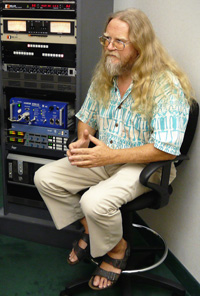Wheatstone Minister of Algorithms
The most basic, and arguably the most powerful, tool for getting vocals to sound good is equalization. It has two primary uses, to correct for errors or for artistic effect. Compression and limiting also can be useful for adjusting vocals, as I cover in some detail below.
But first, this PSA: The worst judge of microphone processor settings is the one doing the talking. Most folk swoon over massive proximity effect bass and vertigo-inducing compression in their own headphones, to extents that would be ludicrous on-air. Someone other than the talent should do the equalization and dynamics adjustments, thank you very much.
Equalization for Error Correction
Microphone manufacturers design their microphones to be used in a given expected manner, and they are measured, qualified and deemed accurate used in that way. That we rarely use them as such is where equalization comes in. Almost without exception directional microphones suffer from one of those pesky laws-of-physics things called “proximity effect;” figure-eight microphones (ribbons usually are) are the worst, but the common super-cardioids and cardioids aren't far behind. It is a tilting up of the low-frequency response of the microphone as one gets closer to it, and although beloved by many, it becomes seriously over-boomy at extreme. The microphone can start to sound thin as one recedes further from it than the magic design distance. What distance? About a foot in the case of common large-diameter dynamic microphones, further with good condensers. The rule-of-thumb for the BBC's use of ribbons used to be more of a rule-of-arm's-length! Needless to say, in practice, microphones are invariably used WELL within excess proximity effect.
A low-frequency shelving equalization section can do a good job of correcting for proximity effect. A wrong-headed approach is to try to use the high-pass filter to do this -- generally they are too steep (too rapid a rolloff) to be a good match for the more gentle tilting response. A shelving section is far more suited.
A high-frequency shelving section is excellent for establishing an overall tonal balance for the presenter/microphone combination, particularly once any sibilance issues have been dealt with by the de-esser (see my previous article Live and Local), and proximity effect is dialed out with LF shelving. Particularly bright microphones (budget condensers in particular named and shamed) can benefit mightily from de-brightening with this section!
A parametric, or sweepable bell-shaped equalization section, can be of use in minimizing unfortunate characteristics of the microphone. (Or indeed of the presenter...) In particular, some dynamics and certainly some lower end condensers have a high-mid boosting peak, in the name of “articulation” but which in today's better and more controlled air-chain environment can just plain sound harsh. Dialed in to, say, between 2kHz and 5kHz with a fairly low Q (broad bandwidth) and just a touch of cut can make a world of difference.
EQ for Artistic Effect
There are no rules for 'artistic' EQ. Whatever sounds right, is right, to quote the immortal Mr. Meek. Just remember other people have to listen to this thing, too.
Compression Purposes
Rather like equalization, compression is basic but powerful and has both technical and formal uses as well as for unabridged artistic effect.
The primary “formal” usage is to maintain a more consistent output level accommodating speakers of differing loudness or different excitement levels of the same presenter. Oh, and compensating for poor microphone technique, where the guy weaves around -- this is a problem exacerbated by close-talking. For this, Automatic Gain Control (AGC) using fairly long attack and release times in the low hundreds of milliseconds is a good starting point, with a high input-output gain reduction ratio steeper than, say, 3:1. The output level is set to match the facility level structure -- usually and unfortunately today that means as high as one dares before distortion sets in with the loudest screamer.
More aggressive settings (shorter attack and release times, deeper compression) imbue a heightened sense of urgency, weight (and yes, loudness) to the voice whilst controlling the output level more tightly. Most presenters LOVE compression!
Limiting
This can be considered a special case of compression, but with very fast attack times and fast release, and an “infinite” ratio, meaning its output level is constrained tightly once the input level has crossed the threshold. Protection is what limiting is about, providing a good, known ceiling to the processor's output level. In the modern idiom, this is usually set at a few dB below 0dBfs. Although fast limiting can be used for effect (and building loudness, if that's the goal), that is best left to the full compressor section which has a greater range of control. No, limiting is generally designed to serve and protect, hopefully gracefully and transparently.


